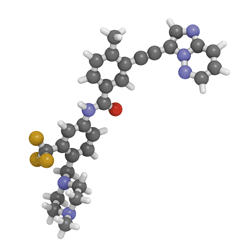Advances in Large-Scale Heterocyclic Synthesis
New practical approaches to the synthesis of complex heterocycles are reviewed.

Medicinal chemistry generally involves the preparation of a lead drug candidate on a milligram scale and uses non-optimized chemistry that will produce the target in the shortest time possible. Often hundreds to thousands of compounds must be synthesized for testing against the target. The chemistry to the specific target is therefore typically not optimized but is phase-appropriate for this stage of development. The process chemistry group then develops safe, robust, and efficient chemistry to enable the preparation of multi-kilogram quantities of the API. This approach is the case for complex heterocyclic APIs. Recent efforts at Genentech and Pfizer and by Phil S. Baran at The Scripps Research Institute have led to improved, practical methods for the synthesis of such complex heterocyclic compounds.
Benzoxazepine synthesis at Genentech
In one case study from Genentech, the PI3k β-sparing inhibitor Taselisib (GDC-0032) was discovered as a potential treatment for breast cancer (1). The main structural feature of Taselisib is a seven-membered benzoxazepine core that is substituted with a functionalized pyrazole at one end and an N-isopropyl-3-methyl-1,2,4-triazole heterocycle at the other end.
The discovery route to prepare the benzoxazepine core of Taselisib required eight chemical steps from commercially available 3-bromophenol, according to Travis Remarchuk, a scientist in the small molecule process chemistry group at Genentech. He notes that while this chemistry was successful for producing the first five kilograms of the benzoxazepine core, it involved the use of hazardous reagents including carbon monoxide gas, N,N-dimethylacetamide dimethyl acetal, and 1,2-dibromoethane and, therefore, was not amenable to the large-scale production of hundreds of kilograms. As a result, it was necessary to consider alternative and more practical routes for the preparation of the benzoxazepine core.
In the second-generation process route, Remarchuk explains that a pre-assembled N-isopropyl-3-methyl-1,2,4-triazole was prepared via a one-pot, two-step synthesis from isopropylhydrazine. This triazole was then converted to a chloroketone derivative, which was directly reacted in a convergent manner with an aryl amidine to generate the fluoroaryl imidazole ring system. The seven-membered benzoxazepine core compound was then installed via alkylation with ethylene carbonate. “Notably, this reagent is a much safer alternative to 1,2-dibromoethane,” says Remarchuk. Following alkylation of the imidazole, the hydroxyl group underwent SN2 substitution with the aryl fluoride of a second equivalent of the imidazole in the same reaction pot to afford the carboxylic acid precursor to the API. “Using this approach, which involved more efficient methods for assembling both the imidazole ring system and the 1,2,4-triazole component, more than 60 kg of the product was manufactured for the Phase I resupply of the API,” Remarchuk observes.
A third-generation route was then developed that involved an efficient three-step, one-pot synthesis of the carboxylic acid precursor. In addition, in the final step of the API synthesis, the carboxylic acid group was converted to the primary amide using 1,1-carbonyldiimidazole (CDI) in place of the guanidinium coupling reagent HATU, which is not attractive for use in the last step of the synthesis due to release of several byproducts (tetramethylurea, hydroxybenzotriazole, and hexafluorophosphate anion) that require rigorous analytical testing to mitigate any safety risk for the patients, according to Remarchuk. The CDI coupling reagent is used in several other Genentech small molecule APIs in development.
Pyrazinyl-imidazo and pyrazinyl-pyrazolo pyridines from Pfizer
Pfizer was interested in compounds containing 5/6 fused ring systems as candidates for oncology treatments. One of the lead compounds, a 3-pyrazinyl-imidazo[1,2-a]pyridine was initially prepared via a palladium-catalyzed reaction of 2,6-dichloropyrazine involving direct arylation at the 3 position of the imidazo ring. This reaction was not amenable to the synthesis of a library of compounds. In addition, few imidazo pyridines are commercially available, and they were synthesized using chloroacetaldehyde, which is a toxic reagent. Therefore, an alternative route to 3-pyrazinyl-imidazo[1,2-a]pyridines for both compound library synthesis and potentially larger-scale preparation was needed.
Based on the known reaction of a dithiane with 2,6-dichloropyrazine involving nucleophilic tele-substitution, Michael R. Collins, a senior principal scientist at Pfizer, attempted the reaction of 2,3-dichloropyrazines with methyl vinyl ether (metallated), which proceeded as desired to afford the 2,6-disubstituted pyrazine products in good yields (50-60%) (2). A range of 3-pyrazinyl-imidazo[1,2-a]pyridines were then obtained in 31-76% yield by reacting the enol ether intermediates with N-bromosuccinimide in dioxane/water to generate the corresponding hemiacetals, followed by the addition of a 2-amino pyridine without isolation (2). In this reaction, the ring nitrogen of the pyridine displaces the bromide of the bromohydrin. “This reaction is very advantageous because it is done in one pot,” says Collins. The overall yields for both steps were also higher than those obtained for the palladium-catalyzed direct arylation route. “Not only does the reaction proceed fairly rapidly in decent yields, it is possible to prepare a wide variety of imadazo heterocycles, which is important for library synthesis,” Collins observes. He adds that substituents in the 6-position of 2-amino pyridine do not hinder the reaction with the enol ether. The analogous compound was formed only in trace quantities using the Pd catalyzed procedure.
Separately, Collins and his colleagues developed an efficient route to 3-pyrazinyl-pyrazolo[1,5-a]pyridines via the [3+2] cycloaddition of enol ethers and 4-substituted 1-aminopyridinim iodides that is, according to Collins, simple to perform, scalable, and proceeds at room temperature. In addition, the reaction proceeds in good yield with 1-aminopyridinium iodides bearing both electron withdrawing and electron donating substituents at the 4-position (3). In this case, to identify the optimum reaction conditions (base and solvent), a high-throughput reaction screen was performed. According to Collins, the best results were obtained using potassium tert-pentylate, sodium hydride, or potassium hexamethyldisilazide in tert-amyl alcohol with a pyrazinyl enol ether.
Sulfur reagents for the alkylation of heterocycles from Scripps and Pfizer
The Baran group at The Scripps Research Institute, in conjunction with Collins and his colleagues at Pfizer, has also recently developed new reagents for the functionalization of heteroarene compounds. In one example, inexpensive, carboxylic acids are converted to sulfinate salts via an interrupted Barton decarboxylation reaction (4). The generated sulfinate salts are high value reagents and efficient radical precursors. The researchers readily prepared 10 different sulfinate reagents. One of the most interesting, according to Collins, is trifluoromethyl cyclopropyl sulfinate (TFCS-Na), which is effective for the C-H functionalization of various heterocycles. Most importantly, the reaction of the sulfinates is highly tolerant of a wide variety of functional groups, thus allowing for the introduction of substituents in the later stages of a synthesis, according to Collins.
In a second example, Baran and the Pfizer researchers developed a practical method for the methylation of heteroarenes via C-H functionalization using zinc bis(phenylsulfonyl-methanesulfinate), or PSMS (5). This reagent was designed based on S-adenosylmethionine (SAM), a biologically relevant methylating reagent. In the reaction with PSMS, a (phenylsulfonyl)methylated intermediate is generated that is readily separated from the reaction mixture, and subsequent desulfonylation reveals the methylated (or deuteriomethylated) product. As with the previous sulfinate-based C-H activation reaction, this transformation proceeds under mild conditions in air at room temperature and tolerates numerous functional groups, allowing for functionalization of pharmaceutical intermediates in the later stages of complex synthetic routes, according to Collins.
References
1. C.O. Ndubaku et al., J. Med. Chem., 56 (11) 4597-4610 (2013).
2. M.R. Collins et al., Tet. Lett., 51 (27) 3528-3530 (2010).
3. M.R. Collins et al., Tet. Lett., 53 (33), 4372-4375 (2012).
4. P.S. Baran et al., Ang. Chem. Int. Ed., 53 (37) 9851-9855 (2014).
5. P.S. Baran et al., J. Am. Chem. Soc., 136 (13) 4853-4856 (2014).
About the Author
Cynthia A. Challener is a contributing editor at Pharmaceutical Technology.

Drug Solutions Podcast: A Closer Look at mRNA in Oncology and Vaccines
April 30th 2024In this episode fo the Drug Solutions Podcast, etherna’s vice-president of Technology and Innovation, Stefaan De Koker, discusses the merits and challenges of using mRNA as the foundation for therapeutics in oncology as well as for vaccines.
Drug Solutions Podcast: Applying Appropriate Analytics to Drug Development
March 26th 2024In this episode of the Drug Solutions Podcast, Jan Bekker, Vice President of Business Development, Commercial and Technical Operations at BioCina, discusses the latest analytical tools and their applications in the drug development market.
INTERPHEX 2025: Use of Walk-In Chambers for Bio/Pharma Development and Manufacturing
April 2nd 2025Sitting down with the PharmTech Group at INTERPHEX 2025, Christopher Murphy, director of Global Business Development and Service Customer Support at Environmental Specialties, discusses the design and critical role of walk-in chambers in the bio/pharmaceutical industry.